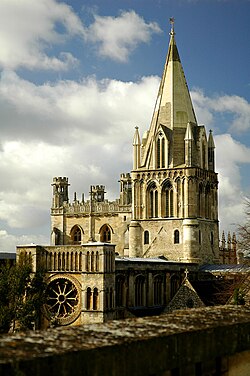Christ Church Cathedral, Oxford
Christ Church Cathedral is the cathedral of the diocese of Oxford, which includes the City of Oxford and the surrounding countryside as far north as Banbury. It is also, uniquely, the chapel of Christ Church, the largest college of the University of Oxford.
History
The cathedral was originally the church of St Frideswide's Priory. In 1522, the priory was surrendered to Cardinal Wolsey, who chose it as the site for his proposed college. However, in 1529 it was taken over by King Henry VIII. Work stopped, but in June 1532 the college was refounded by the King. In 1546, Henry VIII transferred to it from Osney Abbey to the see of Oxford. The cathedral has the name of Ecclesia Christi Cathedralis Oxoniensis, given to it by King Henry VIII's foundation charter.
Architecture
The nave, choir, central tower, and transepts (as far as the roofs) are late Norman, and were probably erected during the lifetime of Canutus, the second prior, in the 12th century. As a whole the cathedral contains examples of the various styles from late Norman to Perpendicular.
Not the smallest
Once this was the smallest cathedral in England. But according to their website, this has changed:
- "It is true that at one time Christ Church Oxford would have been the smallest Cathedral in England... However, with the creation this century of new cathedrals which had previously been parish churches, Christ Church lost its distinction of being the smallest Cathedral in the country.
- 1546 Christ Church Oxford (present size - 16,413 sq ft)
- 1905 Birmingham Cathedral: 13,720 sq ft
- 1914 Chelmsford Cathedral: 11,270 sq ft
- 1927 Derby Cathedral: 10,950 sq ft
- Newport Cathedral in Wales, is smaller still. A Cathedral since 1949, with an area of about 7,850 sq ft, it has a total seating capacity of only 600!
- At present Christ Church is probably the fifth smallest English Cathedral after Derby, Chelmsford, Birmingham and Leicester".[1]
Miscellany
Cathedral (or Christ Church) Time is traditionally five minutes behind Greenwich Mean Time. This dates back to the days before the railways when each region of the country kept to its own local time. Hence what is now called Cathedral Time is a survival of old Oxford Time.[1]
Christ Church Cathedral, Oxford Media
Memorial to John Wesley and Charles Wesley, leaders of the Methodist revival in Christ Church Cathedral, Oxford, where they were ordained while they were Anglicans
Window in north transept depicting St Michael
References
Other websites
| Wikimedia Commons has media related to Lua error in Module:Commons_link at line 62: attempt to index field 'wikibase' (a nil value).. |










